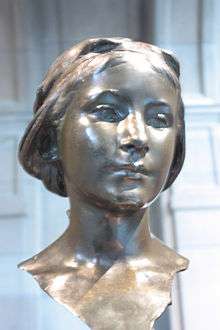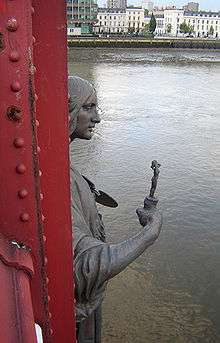Alfred Drury
(Edward) Alfred Briscoe Drury RA (11 November 1856 – 24 December 1944) was an English architectural sculptor and figure in the New Sculpture movement.[1][2] Drury is best represented at the Victoria and Albert Museum, where he contributed the figure of Prince Albert immediately above the main entrance, nine lunettes with Drury's characteristic allegorical girls each bearing a portion of the museum's motto, allegorical figures of Inspiration and Knowledge, and Queen Victoria above it all, carrying a staff and flanked by a knight and angel. (The spandrel figures of Truth and Beauty are by George Frampton.)



Biography
He was born in Islington, London on 11 November 1856. Drury studied under the Frenchmen Édouard Lantéri and Jules Dalou, with whom he worked between 1881 and 1885, and then became assistant to Joseph Boehm.
He was elected an Associate of the Royal Academy of Arts in 1900 and a full Academician in 1913.[2] He was also member of the International Society of Sculptors, Painters and Gravers.[3]
He died on Christmas Eve, 24 December 1944.[1][4][5][6]
Works
- Four allegorical pairs on the Old War Office, Whitehall, 1905, representing Sorrow and Joy, Horror and Dignity of War, Truth and Justice, and Victory and Fame.[2]
- Four colossal bronzes on the downstream side of the Vauxhall Bridge representing Education, Fine Art, Science, and Local Government
- The Boer War Memorial in the Cloisters at New College, Oxford
- A figure of Joshua Reynolds for the forecourt of Burlington House, home of the Royal Academy
- Gatepost figures representing West Africa, Canada and South Africa as part of Thomas Brock's Victoria Memorial, London[2]
- A pair of figures and other sculptural work for the London Troops War Memorial at the Royal Exchange, London designed by Sir Aston Webb[2][7]
- A statue of Alexander McLeod in front of the Royal Arsenal Co-operative Society building in Powys Street, Woolwich[8]
- Rhodes University (Grahamstown) War Memorial to the 1914-1918 and 1939-1945 conflicts, depicting a medieval knight in armour and chain mail, with gauntletted hands resting on the hilt of his sword.
Gallery of sculptural work
- London Troops Memorial, Royal Exchange
- Statue of Joshua Reynolds, London
 Statue of Alexander McLeod, Woolwich
Statue of Alexander McLeod, Woolwich Statue of Joseph Priestley, Leeds
Statue of Joseph Priestley, Leeds One of 8 nymphs as lamp holders, Leeds City Square
One of 8 nymphs as lamp holders, Leeds City Square
Notes
- "Alfred Drury, 88, British Sculptor. Londoner, Noted for Statue of Sir Joshua Reynolds, Dies. Works Seen by Millions". The New York Times. December 25, 1944. Retrieved 2015-03-02.
- Quinlan.
- "The International Society of Sculptors, Painters and Gravers". Mapping the Practice and Profession of Sculpture in Britain and Ireland 1851-1951. Glasgow University. Retrieved 31 May 2013.
- Mapping the Practice and Profession of Sculpture in Britain and Ireland - 1851-1951
- Chamot, p. 157.
- Mark Stocker, 'Drury, (Edward) Alfred Briscoe (1856–1944)', Oxford Dictionary of National Biography, Oxford University Press, Sept 2004
- UKNIWM Ref 11796
- Co-op Changes Commence, on e-shootershill.co.uk, January 23, 2012. Retrieved 2015-07-24.
References
- Mary Chamot, The modern British paintings, drawings, and sculpture, London, Oldbourne Press, 1965. OCLC 512918
- Mark Quinlan, Sculptors and Architects of Remembrance, Sandy, Authors Online, 2007, ISBN 978-0755203-98-7.